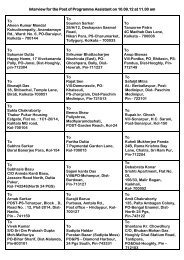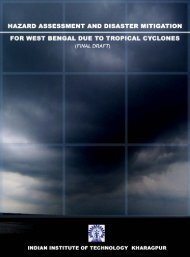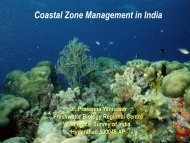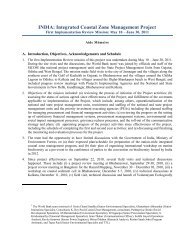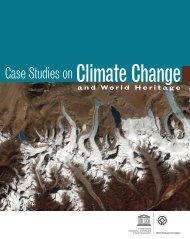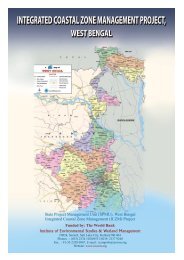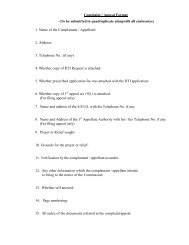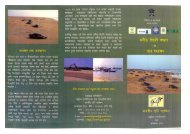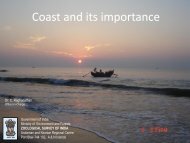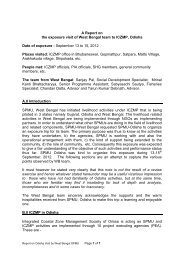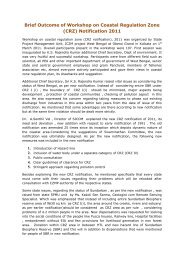integrated coastal zone management project west ... - Iczmpwb.org
integrated coastal zone management project west ... - Iczmpwb.org
integrated coastal zone management project west ... - Iczmpwb.org
Create successful ePaper yourself
Turn your PDF publications into a flip-book with our unique Google optimized e-Paper software.
146111. The east coast of India is prone to incidences of cyclones. Records of incidence ofcyclonic storms and severe cyclonic storms in Orissa section of the Bay of Bengal of IndiaMeteorological Department (1877 to 1980) give the average month wise numbers as follows:January 0 (0) July 36(7) April-May 8(7)February 0 (0) August 29(4) June-September 118(22)March 0(0) September 29(8) October-December 29(14)April 0(0) October 20(9) Annual 155(43)May 8(7) November 9(5)June 24(3) December 0(0)The probable maximum storm surge in metres that expected is as follows:Contai – 12.5 Sagar – 11.5 Moore Island - 8.5Earthquakes112. There are records of a number of moderate magnitude (M 4 to 5.5) earthquakes inthe <strong>coastal</strong> areas of West Bengal. A few of them are : 11.10.1937 (22.6/88.4) with intensityX, 9.12.1852 (22.4/88.4) with magnitude 5.7, 23.1.1860 (21.8/87.8) with magnitude 5.0,26.12.1906 (22.6/88.4) with magnitude 5.0, 15.4.1964 (21.7/87.7) Contai earthquake withmagnitude 5, 27.4.1993 (22.0/88.0) with magnitude 4.2 and 12.6.1993 (21.8/89.7) withmagnitude 5.7. Depth of focus of thee earthquake events varies from a few km to 60 km. Themaximum intensity reached around the mouth of Ganga has been VIII in MM scale.113. The Indian Bureau of Standard has divided the whole country into 4 <strong>zone</strong>s (Zone IIto V according to the expected earthquake hazard potential of the country – <strong>zone</strong> II havingminimum vulnerability and <strong>zone</strong> V having maximum hazard potential. According to thisclassification, <strong>coastal</strong> areas of West Bengal east of the mouth of Ganga fall in <strong>zone</strong> IVhaving expected earthquake intensity of VII in MSK scale. The <strong>coastal</strong> areas lying <strong>west</strong> ofmouth of Ganga fall in <strong>zone</strong> III having expected earthquake intensity of VII in MSK scale.Therefore, it is clear that the <strong>coastal</strong> areas of West Bengal are vulnerable to face damages byearthquake of moderate magnitudeTsunamis114. A major and devastating tsunami affected parts of <strong>coastal</strong> areas of Andaman &Nicobar Islands and <strong>coastal</strong> states of Andhra Pradesh, Tamil Nadu and Kerala on December26, 2004. The tsunami was generated because of an earthquake (M 9.1) in the Bay ofBengal. The earthquake and the attendant tsunami originated due to <strong>west</strong>ward thrust given tothe water column of the ocean by a landmass (Myanmar, Andaman and Sunda micro-plate)measuring 1200 km by 150 km that moved along the inclined plane (subduction <strong>zone</strong>) over





